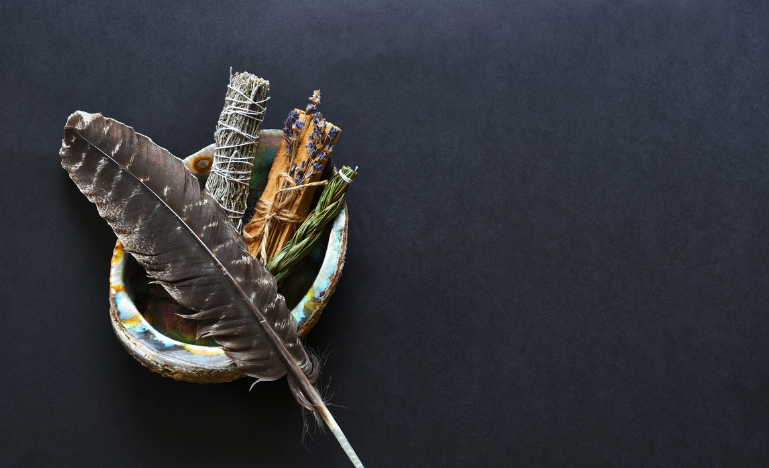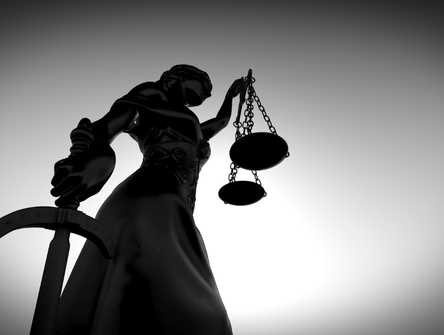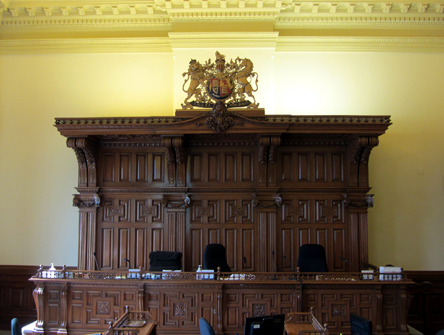Reconciliation in the courtroom
Chief justice says Indigenous legal orders have lots to teach us about resolving conflict, repairing harm and restoring relationships

Smudging ceremonies, eagle feathers, and circle seating with no judge's dais in sight are becoming more common in courtrooms across Canada as recognition of Indigenous legal orders increases. This reflects a growing understanding that reconciliation with First Peoples must include meaningful actions that promote inclusion.
In the latest episode of the Modern Law: Verdicts and Voices podcast, host Alison Crawford speaks with two guests who have been at the forefront of reconciliation initiatives in their courts; Chief Justice Glenn Joyal of the Manitoba Court of King's Bench, and Chief Justice Leonard Marchand of the BC and Yukon Courts of Appeal.
When Marchand, who is also Salish and a member of the Okanagan Indian Band, headed up British Columbia’s Provincial Court bench, he worked with specialized Indigenous sentencing courts for those charged with criminal offences.
“They don't conduct trials. They're not for people who deny or intend to defend the charges they're facing,” he says.
“They're for people who identify as Indigenous to indicate that they intend to plead guilty. Generally, most courts have the Crown counsel’s agreement that the case is appropriate for the more restorative approach of the sentencing courts.”
The differences often start with the court’s physical layout; in an Indigenous sentencing court, judges are quite literally at the same level as the defendants.
“We sit in as much of a circle as we can,” Marchand says.
The standard judge's dais is removed, along with the counsel table and the witness box.
“It just allows a more informal style of relating to and speaking with one another and connecting,” he says.
Court sittings typically begin with a smudging ceremony for those who wish to participate and an opening prayer. From there, participants are provided pre-sentencing reports, including Gladue reports, and the Crown outlines the circumstances of the offence and the Crown's position on sentencing.
“Defence counsel then has an opportunity to reply, but typically, the lawyer doesn't talk,” Marchand says.
“The client talks about how they came into conflict with the law and their plan to put things right.”
Often, family and community members provide observations and thoughts, and sometimes victims do as well. Elders ask questions, offer words of encouragement, and provide suggestions.
The sentencing courts also help develop healing plans for Indigenous offenders.
“The judge typically imposes a community-based sentence with an attached healing plan to help the client avoid jail and put their life back on track,” Marchand says.
“(That’s) not just for the benefit of themselves, of course, but also for the benefit of their family, for the benefit of their community, and really that benefits all of us.”
A blanketing ceremony often follows a successfully completed sentence, which “nearly all of them” are.
In 2017, the Manitoba Court of King's Bench launched the Trust, Reconciliation and Access to Justice Committee in response to the Truth and Reconciliation Commission’s 94 Calls to Action. The single largest number of calls was directed towards the justice system.
The committee is founded on four key pillars: efforts to build trust and understanding with Indigenous communities, enhancing judicial awareness and understanding of reconciliation, enacting change, and normalizing attentiveness to the access to justice challenges facing Indigenous Manitobans.
Joyal says the Manitoba Court of King's Bench has incorporated Indigenous practices such as the ceremonial use of the eagle feather, smudging, and jigging. However, implementing Indigenous legal and cultural practices at other courts is happening at different paces across the country, and challenges are preventing a widespread national effort.
“There's a practical issue - not every province is facing the same demographic imperative with respect to the challenge that the justice system faces for our Indigenous co-citizens,” he says.
Some judges are apprehensive about engaging too deeply with these kinds of projects, concerned they may be seen as compromising their judicial independence. However, Joyal says this view fails to understand the paradox of judicial independence.
“Yes, on the one hand, we have to be very, very attentive and careful of our impartiality, and careful that we retain, protect and promote judicial independence. But the paradox lies in the fact that we're living in an age now where there are social, real imperatives that require us to become engaged,” he says.
“If we're seen as too passive, too remote, too detached, for example, on an issue of judicial reconciliation, we risk the very public confidence that those judges who want to retain their impartiality and judicial independence are trying to protect.”
There’s also a concern that if courts incorporate special cultural practices for Indigenous litigants, they will have to bring in cultural practices for all litigants.
“The problem with that is it de-emphasizes what is unique and special and deserving of an asymmetrical approach when it comes to Indigenous law and traditions,” Joyal says.
“If we are moving, as I believe we are and should, to a tri-jural system, it's not fair and it’s not rational to try to compare so literally and so symmetrically the arguments about liberal neutrality with respect to what we owe our Indigenous community.”
Marchand adds: “I mean no disrespect to anyone else's heritage or beliefs, but the courtroom looks kind of like a cathedral,” where the judges wear robes and “everybody bows to one another.”
“That feels neutral to some people in Canada, but it doesn't feel very neutral to other people. So why do we have those ceremonies, but not other ceremonies?” he asks.
“What we're talking about is things to level the playing field and to make sure that we have a justice system that's welcoming for everyone, and that is for everyone.”
The reality is that legal pluralism, the operation of two or more legal orders within the same geographical jurisdiction or social space, already exists in Canada.
“Our most obvious example is the coexistence of the common law in most of the country and civil law in Quebec,” Joyal says.
And historical cases as far back as 1867 recognized the existence of Indigenous law. That year, the Quebec Superior Court held that a marriage conducted in accordance with Cree custom was legally valid.
“From my perspective, Indigenous legal orders have lots to teach us about resolving conflict, repairing harm and restoring relationships,” Joyal says.
“But to benefit from the teachings, we have to first recognize, and if I could put it this way, make space for Indigenous law and legal orders.”
Tune in to the podcast to hear more about where Joyal and Marchand think Indigenous reconciliation in Canada's justice system is headed next.
Also in this episode, we welcome David Parry, chair of the CBA’s Criminal Justice Section, and Deanna Okun-Nachoff, partner at McCrea Immigration Law in Vancouver, to discuss Bill C-2, the proposed new Strong Borders Act. We also look at the landmark Supreme Court of Canada decision on publication bans, Dagenais v CBC, with retired senior counsel for the CBC, Daniel Henry.


